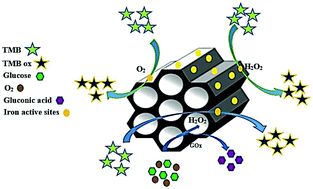当前位置:
X-MOL 学术
›
New J. Chem.
›
论文详情
Our official English website, www.x-mol.net, welcomes your
feedback! (Note: you will need to create a separate account there.)
Enzymatic activity of Fe-grafted mesoporous silica nanoparticles: an insight into H2O2 and glucose detection†
New Journal of Chemistry ( IF 2.7 ) Pub Date : 2018-09-01 00:00:00 , DOI: 10.1039/c8nj03534b M. Aghayan 1, 2, 3, 4, 5 , A. Mahmoudi 1, 2, 3, 4, 5 , M. Reza Sazegar 1, 2, 3, 4, 5 , N. Ghavidel Hajiagha 1, 2, 3, 4, 5 , K. Nazari 5, 6
New Journal of Chemistry ( IF 2.7 ) Pub Date : 2018-09-01 00:00:00 , DOI: 10.1039/c8nj03534b M. Aghayan 1, 2, 3, 4, 5 , A. Mahmoudi 1, 2, 3, 4, 5 , M. Reza Sazegar 1, 2, 3, 4, 5 , N. Ghavidel Hajiagha 1, 2, 3, 4, 5 , K. Nazari 5, 6
Affiliation

|
Mesoporous silica nanoparticles (MSNs) have attracted a lot of notice as a platform in nanomaterials due to their specific properties such as large surface area, high pore size and volume, physical stability and uniform structures. The application of pure MSNs in various industries such as the petrochemical and pharmaceutical industries has been developed. The incorporation of metals into MSNs can increase the catalytic activity of MSNs due to their specific properties such as pore size and volume. Modification of MSNs by iron atoms (Fe-MSN) was studied in this research. The Fe-MSN was prepared using a sol–gel method. Here a comprehensive study was conducted on its enzyme mimicking and biocatalytic activities toward the oxidase, peroxidase and catalase enzymes. Hence, the relevant biocatalytic parameters were obtained through the reliable enzyme kinetic models. The results showed that Fe-MSN has high catalytic activity for decomposition of hydrogen peroxide (catalase activity) and for oxidation of aromatic hydrogen donors such as 3,3′,5,5′-tetramethylbenzidine (TMB). This activity can be carried out in the presence of oxygen as an oxidant (oxidase activity) and/or in the presence of a peroxide substrate, e.g. H2O2 (peroxidase activity) to produce the blue-colored product. Consequently, a colorimetric method was developed to determine H2O2 by Fe-MSN indicating a reasonable limit of detection (LOD) of 1.2 μM (3σ/slope) and a linear range over 7.2–100 μM. When Fe-MSN was coupled with glucose oxidase (a bienzymatic sequential detection system) glucose as a substrate can be detected at ≤1.2 μM over an experimental linear range of 4.1–100 μM.
中文翻译:

铁接枝的介孔二氧化硅纳米粒子的酶活性:对H 2 O 2和葡萄糖检测的认识†
介孔二氧化硅纳米颗粒(MSNs)由于其特殊的特性(例如大表面积,高孔径和体积,物理稳定性和均匀结构)而作为纳米材料中的平台吸引了很多注意。已开发出纯MSN在各种行业(例如石化和制药行业)中的应用。由于金属的特殊性质(例如孔径和体积),将金属掺入MSN可以提高MSN的催化活性。本研究研究了铁原子(Fe-MSN)对MSN的修饰。Fe-MSN是使用溶胶-凝胶法制备的。在这里对它的酶模拟和对氧化酶,过氧化物酶和过氧化氢酶的生物催化活性进行了全面的研究。因此,通过可靠的酶动力学模型获得了相关的生物催化参数。结果表明,Fe-MSN对过氧化氢的分解具有很高的催化活性(过氧化氢酶活性),并且对于3,3',5,5'-四甲基联苯胺(TMB)等芳族氢供体的氧化具有很高的催化活性。该活性可以在作为氧化剂的氧的存在下(氧化酶活性)和/或在过氧化物底物的存在下进行,例如H 2 O 2(过氧化物酶活性)产生蓝色产物。因此,比色法的开发是为了确定ħ 2 ö 2 1.2μM(3 Fe基MSN表示检测限(LOD)的一个合理的限度σ /斜率)并在7.2-100微米的线性范围。当Fe-MSN与葡萄糖氧化酶(双酶顺序检测系统)结合使用时,在4.1–100μM的实验线性范围内,可以检测到≤1.2μM的葡萄糖作为底物。
更新日期:2018-09-01
中文翻译:

铁接枝的介孔二氧化硅纳米粒子的酶活性:对H 2 O 2和葡萄糖检测的认识†
介孔二氧化硅纳米颗粒(MSNs)由于其特殊的特性(例如大表面积,高孔径和体积,物理稳定性和均匀结构)而作为纳米材料中的平台吸引了很多注意。已开发出纯MSN在各种行业(例如石化和制药行业)中的应用。由于金属的特殊性质(例如孔径和体积),将金属掺入MSN可以提高MSN的催化活性。本研究研究了铁原子(Fe-MSN)对MSN的修饰。Fe-MSN是使用溶胶-凝胶法制备的。在这里对它的酶模拟和对氧化酶,过氧化物酶和过氧化氢酶的生物催化活性进行了全面的研究。因此,通过可靠的酶动力学模型获得了相关的生物催化参数。结果表明,Fe-MSN对过氧化氢的分解具有很高的催化活性(过氧化氢酶活性),并且对于3,3',5,5'-四甲基联苯胺(TMB)等芳族氢供体的氧化具有很高的催化活性。该活性可以在作为氧化剂的氧的存在下(氧化酶活性)和/或在过氧化物底物的存在下进行,例如H 2 O 2(过氧化物酶活性)产生蓝色产物。因此,比色法的开发是为了确定ħ 2 ö 2 1.2μM(3 Fe基MSN表示检测限(LOD)的一个合理的限度σ /斜率)并在7.2-100微米的线性范围。当Fe-MSN与葡萄糖氧化酶(双酶顺序检测系统)结合使用时,在4.1–100μM的实验线性范围内,可以检测到≤1.2μM的葡萄糖作为底物。











































 京公网安备 11010802027423号
京公网安备 11010802027423号